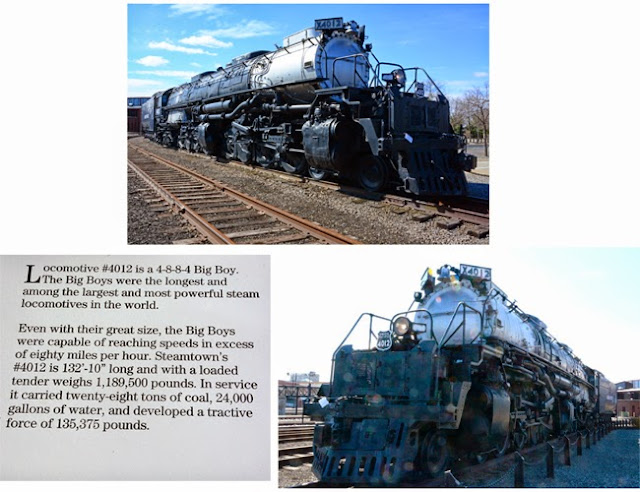The Bennington Elks Lodge is in the perfect camping location
for visiting RVers, who are Elks members, interested in walking around downtown
and in Bennington's long history. It
also is in a historic neighborhood with numerous large mansions, including a
beautiful mansard-roofed carriage house on the Elks property. Several of these
mansions are B&Bs. Monument Avenue
has many classic 18th Century homes and there are many others of 18th
and 19th century vintage around the downtown area of Bennington.
Here are some examples:
 |
| The old mill, now a shopping mall |
Bennington became a city in 1749! It was home to the Catamount Tavern in 1767 when the Green Mountain Boys were formed as a local militia to take on the British. The tavern is long gone now and replaced by a beautiful old home but a large granite base monument with a lifesize Catamount (aka mountain lion!) on top and a plaque tells the story. Lin is interested in the Catamount Tavern story because his first ship in the Navy was the USS CATAMOUNT (LSD-17) named after the Tavern as the meeting place for the Green Mountain Boys!
The famous Revolutionary War Battle of Bennington happened nearby on August 16, 1777 when the Patriots of General John Stark and Colonel Seth Warner triumphed over the forces of British General John Burgoyne! The Battle is memorialized by the very impressive Bennington Battle Monument dedicated in 1891. It is considered the turning point of the Revolutionary War, changing the course of American history, since General Burgoyne surrendered his severely weakened British Army of mainly Hessians shortly afterwards at Saratoga on October 17, 1777!
General Stark is famous for these words to his Patriots as
the battle began: “There they are, boys! We beat them today or Molly Stark
sleeps a widow tonight!” Statues and
tablets of both General Stark and Colonel Warner are front and rear of the
monument, respectively. Reenactments of
the Battle are held here in summer.
This 306 foot obelisk soars over Bennington and is the
tallest structure in Vermont, providing from its 250' high observation area a
view of 3 states—Vermont, Massachusetts and New York. The statistics of the
monument are amazing! Inside there is a
small museum of images of battle scenes and the planning and building of the
monument, as well as financing! An
elevator takes you up to the observation deck about 2/3rds of the way up the
building. The elevator operator is also your guide to orient you and answer
questions. Windows that open allow photographs in each direction. Here are our photographs East, South (looking
down Monument Avenue and Old First Church), West (with New York in the
distance), and North. The Monument is a
state historical site and to go up inside, there is a $5 fee.
A couple of blocks down Monument Avenue is the landmark Old First Church and its Old Burying Ground. Old First is a classically beautiful church built in 1806, replacing an earlier church structure. Its cemetery is fascinating with many old graves from the time of the Revolutionary War and even before. Revolutionary War soldiers and officers are marked with a medallion and small American flags. The most famous burial is poet Robert Frost and his family.
A photographic sample of old gravestones in the cemetery will
give you an idea of the styles of markers of the time and some of the wording.
In a central area of the cemetery there is a large square granite marker for the group burial of both the Patriot and British/Hessian Revolutionary War soldiers lost in the Battle of Bennington. That includes 13 American Patriots, 16 British and Hessian soldiers and one Loyalist who was hung. Tablets on the monuments contain the names of all these men. The inscription reads “Around this stone lie buried many patriots who fell in the Battle of Bennington August 26, 1777. Here also rest British soldiers and Hessians who died from wounds after the battle as captives. They were confined in the first meeting house built in Vermont which stood in the creek west of this burying ground.” Dedicated March 1896
After visiting the Monument and the Church, we drove around Bennington to see the sights and stumbled onto an interesting art project of a type used by many towns as both public art and a fundraiser. We saw a Cow art project/fundraiser about 10 years ago in New York City!
In the case of Bennington, we saw both artistically painted Moose and Catamounts (mountain lions.) Businesses “buy/sponsor” the Moose or Catamount and have an artist paint the fiberglass animal to their chosen theme. After they have been on public display for some period of time, they are auctioned for charity and they show up later at businesses, public spaces, art galleries and more. Great idea! Some of these were in the park by the Chamber of Commerce and others were by an old mill on the roof and another downtown. Hope you enjoy them as much as we did!
I doubt if we saw them all but here are shots of all the Moose, even including a Mom and Calf, that we saw!























































